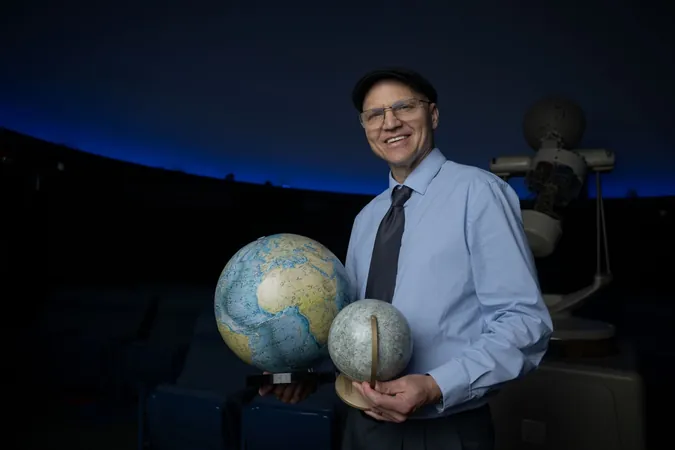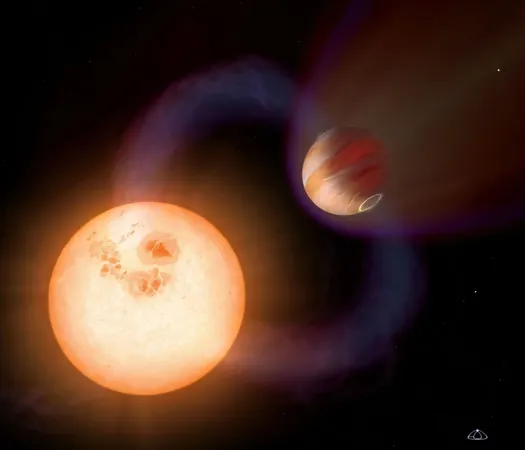
Shocking New Theory Claims Earth's Moon May Have Been Captured from Space!
2024-09-27
Author: Liam
Introduction
Recent revelations from two researchers at Penn State University have challenged the longstanding belief about the origins of our moon. For over four decades, scientists have stood firm on the idea that the moon was formed from the debris of a colossal collision between the young Earth and a Mars-sized body. However, fresh evidence suggests a completely different scenario: that the moon might have been captured during a complicated gravitational dance involving a binary system.
Historical Context
When Apollo astronauts returned from their six missions to the moon between 1969 and 1972, they brought back over 800 pounds of lunar rock and soil. Extensive chemical and isotopic analyses indicated that this material closely resembled Earth’s own geological makeup. This led to a consensus among planetary scientists who gathered at the Kona Conference in Hawaii in 1984, where they concluded the moon's formation was the result of a cataclysmic impact.
New Research Findings
Now, Penn State's Darren Williams and Michael Zugger argue that this narrative may be incomplete. Their new research, published in The Planetary Science Journal, presents the intriguing notion that Earth could have ensnared the moon during a cosmic close encounter, whereby both the moon and another rocky object existed as a binary system before one was captured by Earth's gravity.
Orbit Misalignment
“Questions about the moon’s orbit have persisted for years,” Williams explains. “If the moon formed from a planetary collision, then it should orbit closer to the Earth's equator. Yet, we see that it’s actually more aligned with the sun instead.” This misalignment suggests a different origin story that could change our understanding of lunar history forever.
Comparative Analysis with Other Moons
Adding weight to their claims, the researchers drew parallels with other celestial bodies, notably Triton, Neptune's largest moon, which is believed to have been pulled into its orbit from the Kuiper Belt. Triton displays a retrograde orbit—moving in the opposite direction of Neptune’s rotation—and is significantly tilted in relation to Neptune's equator, much like the moon's trajectory around Earth.
Size of the Captured Object
The data shows it’s conceivable that Earth could have captured a satellite even larger than the moon, potentially an object the size of Mercury or Mars. However, the capture would present stability challenges due to how the initial elliptical orbit of such a satellite would need to settle over time. Williams highlighted that, as the moon's elliptical path evolved into a more circular one due to tidal interactions, its spin synchronized with Earth's gravitational hold.
Ongoing Changes in the Moon’s Orbit
Evidence indicates that the moon migrates away from Earth gradually, at a rate of about 3 centimeters per year. Currently sitting 239,000 miles away, this shifting distance means both Earth's and the sun's gravity exert their influence on the moon now more than ever. "It’s a tug-of-war at cosmic scales," Williams said, suggesting this unique interplay could have played a role in shaping the moon's orbit.
Conclusion
“There’s no definitive answer to how the moon was formed,” Williams admitted, “but we’ve lived with the singular view for too long. Now, we have a second possibility, creating a treasure trove of new questions for scientists to explore in the coming years.”
Could our moon’s path through the cosmos be a story of capture, not collision? As scientific debates continue to unfold, the mysteries of lunar origin seem to deepen, enticing space enthusiasts and researchers alike to embark on a fresh journey into the very fabric of our solar system's history.









 Brasil (PT)
Brasil (PT)
 Canada (EN)
Canada (EN)
 Chile (ES)
Chile (ES)
 Česko (CS)
Česko (CS)
 대한민국 (KO)
대한민국 (KO)
 España (ES)
España (ES)
 France (FR)
France (FR)
 Hong Kong (EN)
Hong Kong (EN)
 Italia (IT)
Italia (IT)
 日本 (JA)
日本 (JA)
 Magyarország (HU)
Magyarország (HU)
 Norge (NO)
Norge (NO)
 Polska (PL)
Polska (PL)
 Schweiz (DE)
Schweiz (DE)
 Singapore (EN)
Singapore (EN)
 Sverige (SV)
Sverige (SV)
 Suomi (FI)
Suomi (FI)
 Türkiye (TR)
Türkiye (TR)
 الإمارات العربية المتحدة (AR)
الإمارات العربية المتحدة (AR)